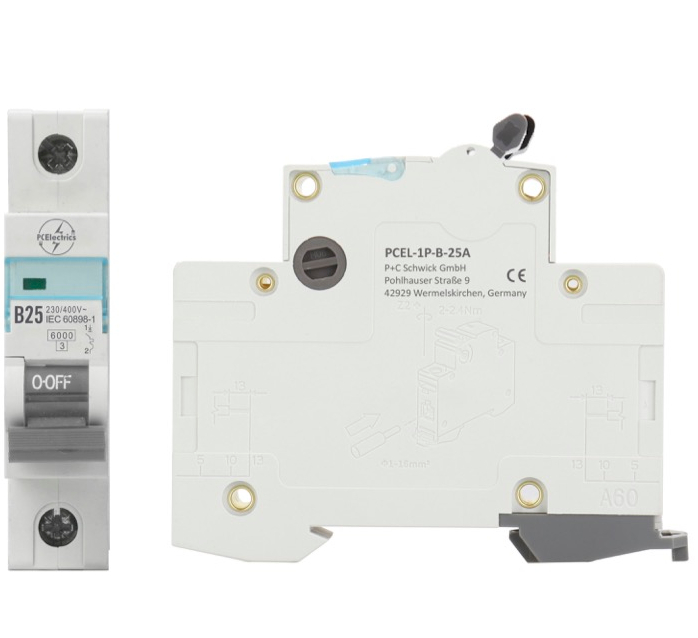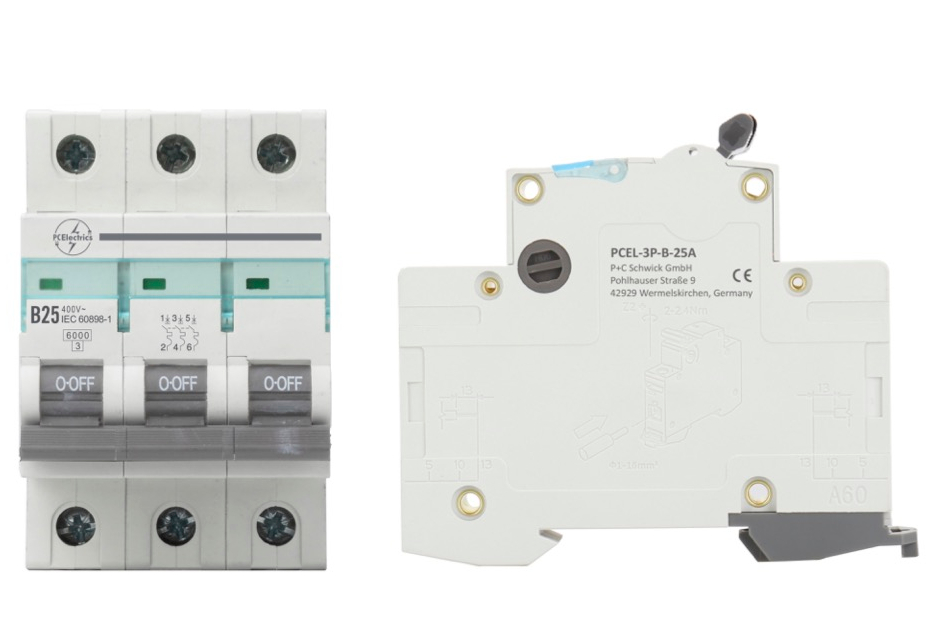Miniature Circuit Breakers (MCB)
- Product num. : 900004
- Manufacturer: PCElectrics
- Manufacturer number: PCEL-1P-B-10A
-
Show more
-
From 1€1.52*
-
From 10€1.41*
-
From 25€1.33*
-
From 50€1.22*
-
From 100€1.16*
Available, delivery time: 1-3 days
- Product num. : 900005
- Manufacturer: PCElectrics
- Manufacturer number: PCEL-1P-B-13A
-
Show more
-
From 1€1.68*
-
From 10€1.55*
-
From 25€1.47*
-
From 50€1.34*
-
From 100€1.28*
Available, delivery time: 1-3 days
- Product num. : 900006
- Manufacturer: PCElectrics
- Manufacturer number: PCEL-1P-B-16A
-
Show more
-
From 1€1.52*
-
From 10€1.41*
-
From 25€1.33*
-
From 50€1.22*
-
From 100€1.16*
Available, delivery time: 1-3 days
- Product num. : 900007
- Manufacturer: PCElectrics
- Manufacturer number: PCEL-1P-B-20A
-
Show more
-
From 1€1.52*
-
From 10€1.41*
-
From 25€1.33*
-
From 50€1.22*
-
From 100€1.16*
Available, delivery time: 1-3 days
- Product num. : 900008
- Manufacturer: PCElectrics
- Manufacturer number: PCEL-1P-B-25A
-
Show more
-
From 1€1.56*
-
From 10€1.44*
-
From 25€1.37*
-
From 50€1.25*
-
From 100€1.19*
Available, delivery time: 1-3 days
- Product num. : 900001
- Manufacturer: PCElectrics
- Manufacturer number: PCEL-1P-B-2A
-
Show more
-
From 1€1.69*
-
From 10€1.57*
-
From 25€1.48*
-
From 50€1.36*
-
From 100€1.29*
Currently not available (delivery time on request)
- Product num. : 900009
- Manufacturer: PCElectrics
- Manufacturer number: PCEL-1P-B-32A
-
Show more
-
From 1€1.60*
-
From 10€1.48*
-
From 25€1.40*
-
From 50€1.28*
-
From 100€1.22*
Available, delivery time: 1-3 days
- Product num. : 900010
- Manufacturer: PCElectrics
- Manufacturer number: PCEL-1P-B-40A
-
Show more
-
From 1€1.69*
-
From 10€1.57*
-
From 25€1.48*
-
From 50€1.36*
-
From 100€1.29*
Available, delivery time: 1-3 days
- Product num. : 900002
- Manufacturer: PCElectrics
- Manufacturer number: PCEL-1P-B-4A
-
Show more
-
From 1€1.69*
-
From 10€1.57*
-
From 25€1.48*
-
From 50€1.36*
-
From 100€1.29*
Available, delivery time: 1-3 days
- Product num. : 900003
- Manufacturer: PCElectrics
- Manufacturer number: PCEL-1P-B-6A
-
Show more
-
From 1€1.56*
-
From 10€1.44*
-
From 25€1.37*
-
From 50€1.25*
-
From 100€1.19*
Available, delivery time: 1-3 days
- Product num. : 900014
- Manufacturer: PCElectrics
- Manufacturer number: PCEL-1P-C-10A
-
Show more
-
From 1€1.52*
-
From 10€1.41*
-
From 25€1.33*
-
From 50€1.22*
-
From 100€1.16*
Available, delivery time: 1-3 days
- Product num. : 900015
- Manufacturer: PCElectrics
- Manufacturer number: PCEL-1P-C-13A
-
Show more
-
From 1€1.68*
-
From 10€1.55*
-
From 25€1.47*
-
From 50€1.34*
-
From 100€1.28*
Available, delivery time: 1-3 days
- Product num. : 900016
- Manufacturer: PCElectrics
- Manufacturer number: PCEL-1P-C-16A
-
Show more
-
From 1€1.52*
-
From 10€1.41*
-
From 25€1.33*
-
From 50€1.22*
-
From 100€1.16*
Available, delivery time: 1-3 days
- Product num. : 900017
- Manufacturer: PCElectrics
- Manufacturer number: PCEL-1P-C-20A
-
Show more
-
From 1€1.52*
-
From 10€1.41*
-
From 25€1.33*
-
From 50€1.22*
-
From 100€1.16*
Available, delivery time: 1-3 days
- Product num. : 900018
- Manufacturer: PCElectrics
- Manufacturer number: PCEL-1P-C-25A
-
Show more
-
From 1€1.56*
-
From 10€1.44*
-
From 25€1.37*
-
From 50€1.25*
-
From 100€1.19*
Available, delivery time: 1-3 days
- Product num. : 900011
- Manufacturer: PCElectrics
- Manufacturer number: PCEL-1P-C-2A
-
Show more
-
From 1€1.69*
-
From 10€1.57*
-
From 25€1.48*
-
From 50€1.36*
-
From 100€1.29*
Currently not available (delivery time on request)
- Product num. : 900019
- Manufacturer: PCElectrics
- Manufacturer number: PCEL-1P-C-32A
-
Show more
-
From 1€1.60*
-
From 10€1.48*
-
From 25€1.40*
-
From 50€1.28*
-
From 100€1.22*
Available, delivery time: 1-3 days
- Product num. : 900020
- Manufacturer: PCElectrics
- Manufacturer number: PCEL-1P-C-40A
-
Show more
-
From 1€1.69*
-
From 10€1.57*
-
From 25€1.48*
-
From 50€1.36*
-
From 100€1.29*
Available, delivery time: 1-3 days
- Product num. : 900012
- Manufacturer: PCElectrics
- Manufacturer number: PCEL-1P-C-4A
-
Show more
-
From 1€1.69*
-
From 10€1.57*
-
From 25€1.48*
-
From 50€1.36*
-
From 100€1.29*
Available, delivery time: 1-3 days
- Product num. : 900021
- Manufacturer: PCElectrics
- Manufacturer number: PCEL-1P-C-50A
-
Show more
Available, delivery time: 1-3 days
- Product num. : 900022
- Manufacturer: PCElectrics
- Manufacturer number: PCEL-1P-C-63A
-
Show more
-
From 1€1.73*
-
From 10€1.60*
-
From 25€1.52*
-
From 50€1.39*
-
From 100€1.32*
Available, delivery time: 1-3 days
- Product num. : 900013
- Manufacturer: PCElectrics
- Manufacturer number: PCEL-1P-C-6A
-
Show more
-
From 1€1.56*
-
From 10€1.44*
-
From 25€1.37*
-
From 50€1.25*
-
From 100€1.19*
Available, delivery time: 1-3 days
- Product num. : 900026
- Manufacturer: PCElectrics
- Manufacturer number: PCEL-3P-B-10A
-
Show more
-
From 1€4.57*
-
From 10€4.23*
-
From 25€4.00*
-
From 50€3.66*
-
From 100€3.49*
Available, delivery time: 1-3 days
- Product num. : 900027
- Manufacturer: PCElectrics
- Manufacturer number: PCEL-3P-B-16A
-
Show more
-
From 1€4.57*
-
From 10€4.23*
-
From 25€4.00*
-
From 50€3.66*
-
From 100€3.49*
Available, delivery time: 1-3 days
Circuit breakers / miniature circuit breakers
Introduction to miniature circuit breakers
Circuit breakers, often referred to as miniature circuit breakers, are essential components of any electrical installation. They protect electrical cables from overloads and short circuits by interrupting the circuit in the event of a fault. These devices make a significant contribution to the safety and reliability of power distribution networks in residential, commercial and industrial buildings.
How circuit breakers work
Circuit breakers work according to a simple but effective principle. They contain two mechanisms: a thermal and a magnetic trigger. The thermal release reacts to overloads by means of a bimetallic strip that bends when heated and interrupts the circuit. The magnetic release reacts to short circuits and disconnects the circuit immediately.
This dual function ensures that both slow overloads and sudden short circuits are detected and rectified, minimizing the risk of damage to the wiring and connected devices.
Types of miniature circuit breakers
There are different types of miniature circuit breakers, each designed for specific applications and load characteristics. The most common types are B, C and D characteristics. Circuit breakers with B characteristics are most commonly found in residential buildings, as they are suitable for standard loads such as lighting and sockets. C-characterized circuit breakers are intended for applications with higher inrush currents, such as motors. D-characterizations are used in industrial areas where very high starting currents can occur.
Installation and maintenance
The installation of miniature circuit breakers should always be carried out by a qualified specialist. Correct installation ensures that the circuit breaker functions optimally and offers the best protection. It is important to select the rated currents and tripping characteristics according to the specific requirements of the electrical installation.
Circuit breakers are generally maintenance-free, but it is still advisable to carry out regular visual inspections to ensure that there is no external damage and that all connections are tight. In the event of malfunctions or after several trips, the circuit breaker should be checked and replaced if necessary.
Safety aspects and benefits
The most important function of miniature circuit breakers is to protect against electrical accidents and fires. Reliably switching off the current in the event of an overload or short circuit significantly reduces the risk of overheating and fires. Circuit breakers also protect against damage to electronic devices and the electrical infrastructure.
Another advantage is the reusability compared to conventional fuses. After tripping, a miniature circuit breaker can simply be switched on again without the need for a replacement part. This saves time and money and is more environmentally friendly.
Modern developments and technologies
As technology has advanced, so has the development of circuit breakers. Modern devices offer additional functions such as residual current protection and combined circuit breakers that can detect overloads, short circuits and residual currents. Such devices significantly increase safety and are becoming increasingly common in modern installations.
Functionalities for remote monitoring and control are also available, which is particularly beneficial in industrial applications. These enable central control and monitoring of the circuit breaker status, allowing maintenance work to be planned more efficiently and downtimes to be minimized.
Choosing the right miniature circuit breaker
There are various factors to consider when purchasing a miniature circuit breaker. These include the rated current, the tripping characteristic, the number of poles and the installation width. It is important to know and observe the requirements of the specific application and the local regulations and standards.
Manufacturers often offer helpful tools and consulting services to help select the right circuit breaker. It is advisable to utilize these resources to make the best choice for your electrical installations.
Conclusion
Circuit breakers are essential components in any electrical system. They ensure safety, protect against overloads and short circuits and contribute to the longevity of electrical cables and devices. The correct selection, installation and maintenance are crucial to fully exploit the benefits of these devices.
Thanks to technological advances, modern circuit breakers offer additional features and higher safety standards that make them an excellent choice for modern electrical installations. Whether you are servicing a residential, commercial or industrial application, a well-chosen and installed circuit breaker is the key to a safe and efficient electrical network.


